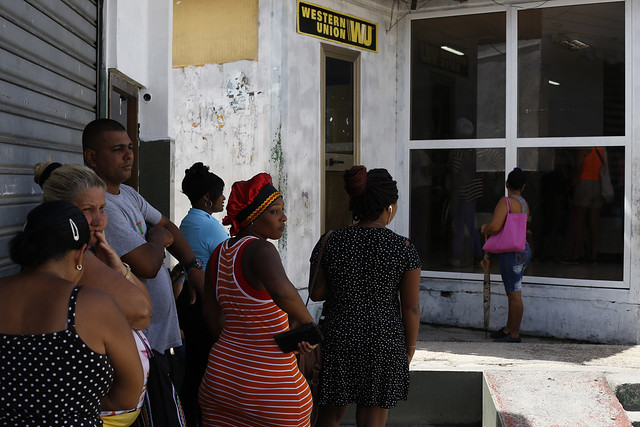Remittances in Cuba: Individual Aid or Collective Business?

By Patricia Grogg (IPS)
HAVANA TIMES – The Cuban government is studying other countries’ experience of channeling the collective benefits of remittances, which reach the Caribbean island every year from the US, Europe and other regions where over a million and a half Cubans have settled.
Official sources admit that these remittances represent a “strong and important” source of revenue for the economy and there is space to channel them towards productive investments. They also recognize that this process includes the need to encourage remittances with benefits for the person sending them.
The Caribbean country doesn’t have any official statistics about the totals of these money transfers, but according to different writers and organizations who study this phenomenon, 1.5-3.6 billion USD are sent in cash every year. These estimates supposedly include legal and illegal transfers.
Higher sums in recent years coincide with the rapprochement of diplomatic relations between Cuba and the US, the largest remittance sender to Cuba. In 2015, 3.354 billion USD were sent and in 2016, 3.6 billion USD, according to figures quoted by Cuban economist Armando Nova.
This researcher and other experts agree on the fact that Cuba needs to take innovative steps so as to ensure that a significant sum of the remittances that reach the country are destined to consumption, essentially, so they can be used in investment and put towards economic growth.
One of the options they consider is the creation of a banking fund for certain state-run or private economic activities, with an attractive interest rate that can be cashed in from time to time whether that’s by the stockholder themselves, or a family member they choose.

Another way would be to invite foreign retail chains to actively take part in the Cuban market, bringing their consignment stock and selling it by mutual agreement and in partnership with national business. Consumers would pay in cash or with an electronic card for this purpose, in USD, euros or other foreign currencies.
Thus, the national economy wouldn’t have to allocate hard currency to importing products and it would manage to channel revenue via remittances and other direct influxes of cash, once commitments have been deducted.
Costs would drop and retail prices wouldn’t have the surcharge or percentage increase that is applied to products sold in the Army’s Hard Currency Collection Stores (TRD) today.
“Real liquid revenue, obtained via remittances, could then be channeled towards the country’s economic growth,” Nova told IPS.
The eventual legalization of small and medium-sized private enterprises, along with the greater autonomy and empowerment of municipalities in the new territorial division endorsed by the new Cuban Constitution, could become an opportunity for remittances to be invested at a local level.
In Latin America, Mexico is the leading recipient of family remittances receiving 33.47 billion USD in 2018, but there still haven’t been successful experiences in the country of remittances being put towards economic growth. And yet this is the case in distant Vietnam, a country where seven out of every ten dollars received in remittances is invested in local companies and business.
According to the experts, one of the reasons that encourages emigrants to send and invest more money in Vietnam is the fact that the country has a prospering economy (it had 6.81% growth last year) and a legal system that allows both nationals living abroad and foreigners to buy assets and property.
Sending remittances to Cuba first became allowed in 1993, these transactions have covered Cuban families’ basic needs. They also cover other expenses today such as communication top-ups, spare parts and repairs or buying a car, doing up or buying a home, private classes and even holidays at 5-star hotels.
In fact, the use of this family aid has become more diversified as Raul Castro’s reforms were put into practice (2008-April 2018), a process which his successor President Miguel Diaz-Canel continues with.
While it isn’t something owners admit easily, many restaurants and hostels, as well as other private ventures, got up off the ground and run with money sent as family remittances.
This equipment, technology and supplies have been paid for in cash abroad, with hard currency that doesn’t enter the country or form part of the liquid cash the Cuban economy receives. Plus, the total sum of remittances covers both liquid cash that enters by different means and goods sent.
“However, it’s very likely that this is considered or recorded as a remittance by those who research the matter abroad,” Nova notes in his article “Remittances to Cuba. Myth or reality, following the money trail,” published on IPS Cuba’s website in July.

Recent figures published by the United Nations, in 2017, register 1,558,312 Cuban emigrants and show that this emigration mostly heads for the US, where 1,251,037 live, representing 80.3% of the total, Spain following far behind (8.58%) and Italy (2.21%).
In these reports, we have to bear in mind the fact that the US counts both immigrants who were born in Cuba as well as Cuban descendants, which according to the US Censor Bureau figure at over two million. On the other hand, immigration changes in 2013 allow Cuban citizens to stay abroad for up to two years, who can also send remittances.
A survey carried out by the Population Studies Center at Cuba’s Office of Statistics in 2016, revealed that 77% of emigrants send some form of aid to their families and friends on this Caribbean island, in a consistent or sporadic manner.
This aid goes to 32% of Cubans who live on the island, with family ties or some other connection to emigrants abroad. It comes in the form of medicine or money mostly and, even taking in relatives for a period of time to look after them, such as grandchildren or other relatives.
In April this year, Donald Trump’s administration limited remittances to the island to only US $1,000 every three months, compared to unlimited remittances which Barack Obama’s government (2009-2017) had established. There is still no data about the impact of this measure.






I have yet to find any data at all on what percentage of remittances is taken directly by the Cuban government.
Why would people living in a communist utopia need any money from the outside?
You are correct Curt. Remittances are a way of demonstrating the benefits of capitalism as compared with the poverty – of both thought, action and standard of living – under communist dictatorship.
No Cuban American who sends remittances and truly cares about their family still living in Cuba would obey the new remittance restrictions cruelty imposed by the Trump Administration. There are just too many ways to get around the new restrictions. I won’t insult anyone’s intelligence by saying what they are, but there is no reason why the restrictions should be felt by any Cuban receiving remittances from the US.
R
Uuh?
Finance,finance,finance will do it.
GAESA also benefits from the charges made for accommodating and staffing Western Union facilities in its stores. The regime also has record of bank transfers made into bank accounts in Cuba – the charges for which are much usually much lower than the high fees charged by Western Union. However, for those wiser folks who take hard currency cash to Cuba and avoid those charges, there is no means for the regime to check the amount that represents tourist expenditure and that which is contributed to Cuban families.
In recent times it has become more evident which families are benefiting from remittances as there has been substantial marketing by GAESA of electric scooters. Five years ago, they could be purchased (from GAESA subsidiaries) for about 1,200 CUC, but the price has now soared to over 2,000 CUC. Electric bicycles that could be purchased for 350 CUC are now over 1,000 CUC as the regime has cashed in on the opportunity in true capitalist fashion.
Any concerns about Cubans exploiting the relatively cheap electricity can be dismissed, as Cuba reverses normal capitalist principles of making lower charges per unit for increased usage and instead increases the charge as the number of units consumed increases.
Cubans receiving remittances in cash can retain them as hard currency in international banks branches in Cuba, avoiding the fear that the regime may eventually make currency “adjustments” to the current two currency system – neither of which is recognized in world markets – with potential inflation.
Just as the effects of Trump’s limited remittances are yet to be fully felt in Cuba, the effect upon Cuban emigres future voting decisions in the US is unknown.